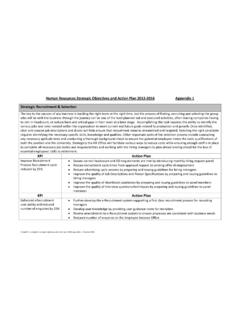Transcription of ECONOMIC DEVELOPMENT PLAN (2016–2020)
1 8th FIVE-YEAR NATIONAL SOCIO- ECONOMIC DEVELOPMENT plan ( 2016 2020)(Officially approved at the VIIIth National Assembly s Inaugural Session, 20 23 April 2016 , Vientiane)Ministry of Planning and Investment June 2016 Lao People s Democratic RepublicPeace Independence Unity ProsperityMinistry of Planning and Investment June 20168th FIVE-YEAR NATIONAL SOCIO- ECONOMIC DEVELOPMENT plan ( 2016 2020)(Officially approved at the VIIIth National Assembly s Inaugural Session, 20 23 April 2016 , Vientiane)FOREWORDThe 8th Five-Year National Socio- ECONOMIC DEVELOPMENT plan ( 2016 2020) 8th NSEDP is a mean to implement the resolutions of the 10th Party Conference that also emphasizes the areas from the previous plan implementation that still need to be achieved. The plan also reflects the Socio- ECONOMIC DEVELOPMENT Strategy until 2025 and Vision 2030 with an aim to build a new foundation for graduating from LDC status by 2020 to become an upper-middle-income country by 2030.
2 Therefore, the 8th NSEDP is an important tool central to the assurance of the national defence and DEVELOPMENT of the party s new , the 8th NSEDP is a result of the Government s breakthrough in mindset. It is an outcome-based plan that resulted from close research and, thus, it is constructed with the clear DEVELOPMENT outcomes and outputs corresponding to the sector and provincial DEVELOPMENT plans that should be able to ensure harmonization in the plan performance within provided sources of funding, including a government budget, grants and loans, domestic and foregin private investments, and investments in the financial system. The plan has also complemented the monitoring and evaluation framework to keep track of implementation progress, which can be a reference for all stakeholders to support, monitor and evaluate the implementation within their domain in each period, especially to support reporting on the progress of the annual, mid-term and end-of-term implementation by achievements, weaknesses, pending issues and challenges that need to be improved and adjusted under the updated Capital, 1 June 2016Dr.
3 Souphanh Keomixay Minister of Planning and InvestmentContentsFOREWORD iiPART I 7th FIVE-YEAR SOCIO- ECONOMIC DEVELOPMENT plan (2011 2015) IMPLEMENTATION REPORT 21. TARGETS AND DIRECTIONS OF THE 7th NSEDP (2011 2015) 22. INTERNATIONAL AND DOMESTIC CONTEXT Global and Regional Context Domestic Context 33. KEY MACROECONOMIC ACHIEVEMENTS OF THE 7th NSEDP IMPLEMENTATION Macroeconomic Achievements ECONOMIC Growth Inflation Fiscal and Monetary Policy Management Money Supply (M2) Foreign Currency Reserves Macro balance Investment for DEVELOPMENT State Budget Balance Import Export Labour and Employment Rural DEVELOPMENT and Poverty Reduction sector Achievements ECONOMIC sector DEVELOPMENT Social DEVELOPMENT Sustainable DEVELOPMENT , Environmental Protection and Natural Resource Management Enterprise DEVELOPMENT Implementation of the Millennium DEVELOPMENT Goals (MDGs) Regional and Local DEVELOPMENT Public sector DEVELOPMENT Implementation of Building province as a strategic unit, district as a strong comprehensive unit and village as a DEVELOPMENT unit National Defence Security International and Regional Cooperation Summary of sector Achievements and Challenges Summary of Achievements Outstanding Issues 7th NSEDP Lessons Learnt to be Applied to 8th NSEDP Design 76 PART II 81 8th NSEDP ( 2016 2020) 814.
4 CONTEXT OF 8th NSEDP Favourable Environment Regional and International Context Domestic Context Anticipated Challenges Regional and International Context Domestic Context Population Policy Issues Sustainable DEVELOPMENT LDC Graduation 855. LONG-TERM PLANS: VISION 2030, STRATEGY 2025 AND MAIN DIRECTIONS FOR 2016 2020 Vision 2030 Ten-year Socio-economicDevelopment Strategy ( 2016 2025) Key Government Direction for the 8th NSEDP ( 2016 2020) 876. OVERALL OBJECTIVE, OUTCOMES AND OUTPUTS OF THE 8TH NSEDP Overall objective and objective-Level Performance Indicators and Targets Outcomes of the 8th NSEDP ( 2016 2020) Summary of Outputs Required to Achieve Each Outcome Outcome 1 Outputs Outcome 1, Output 1: Ensuring Sustained and Inclusive ECONOMIC Growth Outcome 1, Output 2: Macroeconomic Stability Outcome1, Output 3: DEVELOPMENT Planning and Budgeting are Aligned Outcome1, Output4: BalancedRegional and Local DEVELOPMENT Outcome1, Output5: Improved Public/Private Labour Force Capacity Outcome1, Output6.
5 Develop Entrepreneurs, technical experts and professionals Outcome 1, Output7: Regional and International Cooperation and Integration Outcome 2 Outputs Outcome 2, Output 1: Improved Living Standards through Poverty Reduction using the 3-Builds Directions Outcome2, Output2: Food security Ensured and Malnutrition Reduced Outcome 2, Output 3: Universal Access to Quality Education: Outcome 2, Output 4 Universal Access to QUALITY Health Care Services Outcome2, Output 5: Improvement of and Access to Social Protection Outcome 2, Output 6: Protection of national Traditions and Cultures Outcome 2, Output 7: Maintain Political Stability, Social Peace, Order, Justice and Transparency Outcome 3 Outputs Outcome 3, Output 1: Environmental Protection and Sustainable Natural Resources Management Outcome 3, Output 2: Prepare to Cope with the Disaster Risks and Impacts from Climate Change Outcome 3, Output 3: Reducing the Instability of Agricultural Production Caused by Disaster Impact Priority Cross-Cutting Outputs Enhance Effectiveness ofthe Public Governance and Administration Promote Local Innovation and Utilization of Science, Technology and Telecommunications and Management and Application of ICT Promote and Develop Women, Juveniles and Young People 153 PART III.
6 8th NSEDP IMPLEMENTATING MEASURES 1647. POLICIES 1648. IMPLEMENTING MEASURES OF THE 8th NSEDP ( 2016 2020) Macroeconomic Framework Financing plan Revenue and Expenditure Management Production Transit Services and Logistics Science and Technology Application Promotion of Small and Medium-Sized Enterprises Capacity Building 1689. ROLL-OUT OF 8th NSEDP 16910. 8th NSEDP MONITORING AND EVALUATION Key Elements of The 8th Nsedp M&E System Monitoring and Evaluation 170 ANNEXES174 184186187 Annex 1: 8th NSEDP Logical Framework Annex 2: 7th NSEDP Achievement Figures Annex 3: Main Targets Main Targets Of The 8Th NSEDP ( 2016 -2020) Annex 4: Poverty Rate, Poverty Gap And Severity Index, Gini Coefficient Annex 5: Glossary Of Terms 189 LIST OF TABLEST able 1:Comparison between GDP Growth Rate of each Fiscal Year with the 7th NSEDP Targets (2011 2015) 4 Table 2: Gross Domestic Product (GDP) per Capita 5 Table 3: Changes of ECONOMIC Structure in Each Fiscal Year compared with the 7thNSEDP Targets 5 Table 4 : Changes in the Inflation Composition 6 Table 5: Foreign Currency Exchange Rate 7 Table 6: Money Supply Growth 7 Table 7: Foreign Currency Reserves 7 Table 8: Bank Credit Investment 10 Table 9: Summary of Revenue and Expenditure 11 Table 10: Number of Tourist Arrivals and Revenue from Tourism 38 Table 11.
7 Universal Access for Primary Education Indicators 50 Table 12: Gender Equality and Advancement of Women Indicators 50 Table 13: Child Mortality Reduction Indicators 51 Table 14: Maternity Health Indicators 52 Table15: 7th Five-Year NSEDP Performance in the Northern Region 58 Table16: 7th Five-Year plan Performance of the Central Region 61 Table 17: 7th NSEDP Implementation Performance in the Southern Region 63 Table 18: Overall Objective-Level Performance Indicators and Targets 88 Table 19: Outcome Indicators and Targets 91 PART I7th FIVE-YEAR NATIONAL SOCIO- ECONOMIC DEVELOPMENT plan (2011 2015)IMPLEMENTATION REPORT8th FIVE-YEAR NATIONAL SOCIO- ECONOMIC DEVELOPMENT plan ( 2016 -2020)2 PART I 7th FIVE-YEAR SOCIO- ECONOMIC DEVELOPMENT plan (2011 2015) IMPLEMENTATION REPORT1. TARGETS AND DIRECTIONS OF THE 7th NSEDP (2011 2015)The 7th NSEDP (2011 2015) aimed to achieve sustainable ECONOMIC growth and poverty reduction, while gradually transforming Lao PDR into a more open, strengthening the private sector productivity capacity and prioritizing the achievement of the Millennium DEVELOPMENT Goals (MDGs) by 2015.
8 The 7th NSEDP had four overall targets: Ensure continuation of national ECONOMIC growth with security, peace and stability and ensure GDP growth rate of at least 8 percent annually and GDP per capita of at least US$ 1,700 Achieve the Millennium DEVELOPMENT Goals (MDGs), join the ASEAN ECONOMIC Community by 2015, and eradicate poverty; adopt appropriate technology and skills and create favourable conditions for graduating the country from Least Developed Country (LDC) status by 2020 Ensure the sustainability of DEVELOPMENT by emphasizing on ECONOMIC DEVELOPMENT which should include cultural and social progress, natural resources preservation and environment protection, natural disasters mitigation and climage change adaptation Ensure political stability, peace and social order Widened regional and international integrationTo achieve these overall targets, the 7th NSEDP was designed to focus on the followings: Sustainable and inclusive ECONOMIC -centered DEVELOPMENT , poverty reduction and modernization of the economy Rural DEVELOPMENT and poverty eradication, and gap reduction of the urban-rural area and the rich and the poor Education reforms, human resource DEVELOPMENT and livelihood promotion, with emphasis on the expansion of educational opportunities, the improvement of health and sanitation and training to produce skilled workers Increased effectiveness of public administration through rule of law and prevention of corruption Competitiveness by optimizing the use of natural resources, increasing regional cooperation and integration and developing investment promotion policies and industrialization FIVE-YEAR NATIONAL SOCIO- ECONOMIC DEVELOPMENT plan ( 2016 -2020)2.
9 INTERNATIONAL AND DOMESTIC Global and Regional Context1 The implementation of the 7th NSEDP has taken place in a rather challenging environment, especially given a number of international and regional incidents that have direct and indirect impacts on ECONOMIC growth and unrest in society. These include: (i) the debt and financial crisis in the United States, Iceland and a number of countries in the European Union; (ii) increased fuel and food prices in the world market; (iii) political unrest in the Middle East and North Africa; and (iv) a devastating earthquake and tsunami in Japan in March , the ECONOMIC growth of some countries has hindered. The world ECONOMIC growth rate in 2015 was at percent, a decrease of percent from 2014; in the US, the ECONOMIC growth rate decreased from percent in 2010 to percent in 2015; Japan s ECONOMIC growth rate decreased from percent in 2010 to percent in 2015; for the People s Republic of China, the ECONOMIC growth rate decreased from percent in 2010 to percent in 2015.
10 For ASEAN,2 different growth rates were observed. Singapore s economy grew from percent in 2014 to percent in 2015; Indonesia from 5 percent in 2014 to percent in 2015; Malaysian from percent in 2014 to percent in 2015; Thailand from percent in 2014 to percent in 2015; and Vietnam from percent in 2014 to percent in 2015. For countries within the European Union, the ECONOMIC growth rate was expected to remain at percent in 2015, a slight increase of percent. The increase was derived from household expenditure, resulting from higher level of income and employment, while electricity price declined. However, towards the end of the 7th NSEDP implementation period, the world economy generally picked up because of improved ECONOMIC growth and low inflation Domestic ContextBetween 2010 and 2015, the country enjoyed political stability, peace, social order and broadened international cooperation. Prominently, Lao PDR has had the honour to host many important international meetings, such as the 7th Asia Europe Parliamentary Meeting and the 9th Asia Europe Summit in October and November 2012 respectively; the 6th Cambodia Lao PDR Myanmar Vietnam(CLMV) Summit; and the 4th Aryavady Chaophaya Mekong ECONOMIC Cooperation Summit (ACMECS), 12 13 March 2013; and the 35th ASEAN Parliamentary Meeting in 2014.







